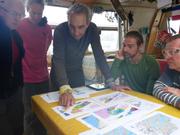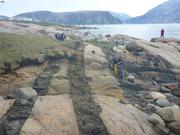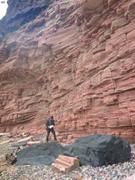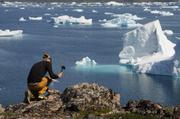Gardar, by Laurent Geoffroy
Gardar, the magmatic province that tectonic and magmatic researchers dream of, is located in the SW of Greenland, in the former territory of the Vikings.
You can pass through this region without noticing much, apart from lush vegetation (relatively at least for Greenland) and a network of very active farms (which, in particular, breed sheep).
But really, the province of Gardar is a hidden treasure. Here, a little over a billion years ago, the continent that would someday become Greenland was subjected to extensional forces that caused the Earth's crust to rift apart and the hot mantle(1) beneath to melt.
In the case of Gardar, the magma was injected into vertical cracks (called dykes), whose width in this special place is extraordinary on the global scale and throughout Earth's history. Here, dykes are up to 1000 m wide, when usually they only reach a few metres in width.
But that's not all, the mineralogical and chemical composition of the associated rocks here is also astonishing(2) (for specialists on the subject that is). Do these magmas really come from melting the deep mantle, as this is the case in more recent extension zones, or from melting the lithosphere itself?
In addition to giant dykes, volcanoes were common in this region one billion years ago. Today, after much erosion, we only see the magmatic roots of these volcanoes.
Some geologists have compared the Gardar to the East African Rift System, where extension is accommodated by faults (cracks) and sometimes by the injection of thin dykes. But we don't think so. The Gardar rift, if we can call it a rift, is unique in its structure and magmatic injection mechanisms.
Did the continents in the Middle Proterozoic (i.e. of Gardar age) have the same mechanical properties as the current continents? If the answer to this question is "no", what does this tell us about the rate of Earth's cooling since its formation?
These are some of the questions that the Protero-Litho2 program (2023-2025), supported by the IPEV (French Polar Institute), proposes to answer - with logistical assistance from the Vagabond, our preferred vessel for our work in Greenland, and her trusty crew.
(1) The hot rocks below the Crust (the outermost layer of the Earth).
(2) Their rare chemical elements are very enriched, with possible economic potential. However, the environmental consequences of exploiting such a resource are difficult to assess.




